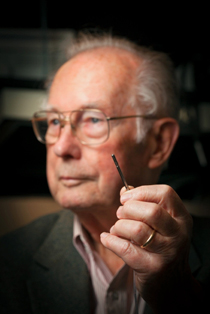NEW YORK CITY
Tiny microscopes will save lives: Weill Cornell doctors have high hopes for multiphoton endoscopy
From precancerous lesions in the bladder to polyps in the colon, pathologists are constantly examining tissue biopsies for diagnoses. Cornell researchers are pushing the limits of the well-established imaging technology called multiphoton microscopy by shrinking the microscopes so they can be inserted safely into a patient's body – minimizing the need for unnecessary biopsies.

Assistant professor Sushmita Mukherjee, director of the multiphoton microscopy facility at Weill Cornell.
The team collaborates with doctors at Weill Cornell Medical College, who will test the prototypes on human tissue samples. Eventually, with FDA approval, the doctors hope the multiphoton endoscope can be used in lieu of, or in tandem with, a traditional low-magnification optical endoscope in the operating room.
"Multiphoton endoscopy can act as an adjunct to our standard evaluation system and, hopefully, diminish the number of unnecessary biopsies we take," says Douglas Scherr, urological surgeon and associate professor of urology at Weill Cornell.
For more than two decades, Watt W. Webb, the Samuel B. Eckert Professor in Engineering and professor of applied and engineering physics, has dreamed of making multiphoton microscopy, which he invented with colleagues in 1990, available in clinical settings to quickly image inside a person's liver, bladder, lung or any other organ. The same technology that uses two-photon excitation to harness cells' intrinsic fluorescence could be housed into the tiny end of a thin endoscope to directly image tissues or tumors.
"The motivation all along was to look at human cells," Webb says.
Webb's lab, in collaboration with Chris Xu, associate professor of applied and engineering physics, is now developing several prototypes of multiphoton endoscopes. The latest – 4 cm in length and 3 mm in diameter – was described online in Proceedings of the National Academy of Sciences, Oct. 17.
Multiphoton microscopy acquires high-resolution images deep below the surface of a tissue sample. This allows visualization of cellular details within unstained tissues that would be useful for pathologists to make diagnostic predictions.
Three Weill researchers – Fred Maxfield, professor and chair of biochemistry; Scherr; and Sushmita Mukherjee, director of multiphoton microscopy and assistant professor of biochemistry – are co-investigators on a National Institutes of Health-funded research grant, in collaboration with Webb's group, on multiphoton endoscopy. They have published several papers on how multiphoton produces fast, reliable and dye-free tissue imaging of human samples from at least seven organs.

Watt W. Webb, the Samuel B. Eckert Professor in Engineering and co-inventor of multiphoton microscopy, holds his lab's latest multiphoton endoscope prototype. See larger image
Equipped with two benchtop multiphoton microscopes, the Weill researchers are testing multiphoton capabilities with tissue from patients (who signed releases) before the tissue is analyzed by traditional pathology methods.
"We not only have the corresponding histology, but also the clinical history of the person, so we know what is going on," says Mukherjee, who runs the lab.
Developing an optical biopsy instrument has been called the "holy grail" for surgical endoscopy – the ability to get identical histologic information as one would obtain from a surgical biopsy without having to extract the tissue from the patient, Scherr says.
Bladder cancers, in which Scherr specializes, have high rates of recurrence because it is difficult to pinpoint and remove every area of malignancy, he explains.
Even so, 70 percent of all bladder biopsies are benign, Scherr says, because with the naked eye, a surgeon cannot distinguish between an inflammatory and a malignant lesion, so they have to biopsy it all to be safe.
The collaborations with Webb's group have proven a fruitful partnership that bridges the gap between applied physics laboratory research and clinical settings, Maxfield says. He recalls Webb's many meetings with doctors, starting in about 2005, when he was pitching the endoscope idea.
"It was actually fascinating to have this physicist come and make appointments with surgeons in various specialties," Maxfield says.